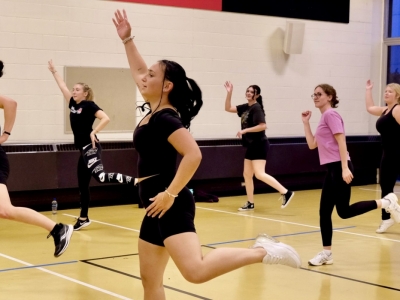By: Manon van Mil
“Twist and tuck!” said my trampoline coach—every practice.
We wondered why he wanted us to practice the cradle: a back drop, half twist, over forwards into a second back drop. Babies use cradles. Noncompetitive trampolinists might. Us? We were so over them.
Then we saw it: a friend and skilled trampolinist flipped over backwards, twice, into a full twist. And missed her feet. Her cradle-training kicked in, and she landed in a back drop – which probably saved her life.
Sometimes ‘failure’ in trampoline means that you are heading towards your face or head. There is no time to ‘think fast.’ We practice cradles all the time so our bodies can work on autopilot.
‘Failure’ can also mean performing below our expectations. In New Toughness Training for Sports, sports psychologist Jim Loehr says that we underperform when mental, emotional, or physical stress exceeds our ability to recover. We become mentally, emotionally, and physically ‘tougher’ by making waves of stress and recovery.
Loehr recommends responding to failure ‘with challenge’: positive fight, spirit, calmness, and confidence. Do not retreat, whine, make excuses, or rage : Do think and act tough.
Responding with challenge is not easy, although it is natural: a baby who makes excuses for missing their first step never learns how to walk. We can reclaim the love of learning and resilience characteristic of the very young by adopting a growth mindset. People who have a growth mindset view failure as a learning opportunity.
I used to believe that I was a good trampolinist because I was naturally strong and flexible. Now I know that it was because I practiced four times a week (for years). I have changed my mind(set) and learned to see failure differently: It happens. To everyone. It does not reflect my capabilities. In fact, the only way to glimpse what I am capable of is to take failure in stride and create even more waves of stress and recovery.
Realizing this does not suddenly make failing easy. In the stress and pressure of the moment, it pays to have practiced—just like we practiced twisting to safety in trampoline. Use every tool you have available to ensure you are responding with challenge, including the following checklist:
- Take a deep breath. Anxiety causes shortness of breath, and vice versa. How we breathe directly impacts how we feel; so take a deep breath to reduce your stress level.
- Deeper. Don’t skip this step!
- Think tough. We are responsible for our thoughts and feelings—psychological factors which significantly impact performance. Consider Loehr’s advice that “while this is tough, (you are) a whole lot tougher.” Tough thinking is positive thinking—even when positive thinking is tough!
- Act tough. Your body language communicates important information to your opponents—and yourself.
- Identify what went wrong. Has your mental stress exceeded your ability to recover? Your emotional stress? Physical?
- Make a plan. Is there any immediate action you can take to recover? Can you take better care of your real self to help your performer self in the long-run? Can you make waves of stress and recovery to develop mental, emotional, or physical toughness?
- Be gritty. Failure is a learning opportunity—but you still have to practice what you (now) know to automatize the behaviour. Many people find sticking to a plan the most challenging part!
- Follow up. Did you respond to failure with challenge? What did you do that wasn’t on this list? What will you do differently next time? (Oh—feel free to share!)



